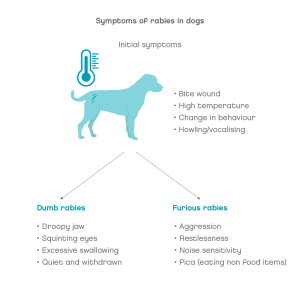Rabies is a very serious, almost always fatal, viral disease that affects the nervous system. It affects all mammals, including dogs, cats, ferrets, and humans. It spreads through the saliva of infected animals, and there is no cure.
Rabies is one of the world’s deadliest zoonotic diseases. Zoonotic means that it transfers from animals to humans.
The UK has been determined to be rabies-free since the early 20th century under international guidelines.
Overview
What causes rabies in dogs?
Rabies is a viral infection. It is present worldwide and affects all mammals, including dogs, cats, and humans.
- It spreads through infected saliva. Usually through bites from infected animals.
- It is also spread through scratches, open sores, and mucous membranes like the eyes or gums.
- The virus attacks the brain and spinal cord.
Dogs start showing signs of the disease on average 2 weeks to 4 months after being infected. This usually depends on where the bite is and how much infected saliva it contains.
Rabies is present worldwide, especially in Asia and Africa. It is responsible for many deaths in those countries.

Common wildlife carriers of rabies abroad include raccoons, foxes, skunks, bats, and mongooses.
Rabies is extremely rare in the UK.
- Though it’s rare, rabies is a notifiable disease, which means it’s the law to report cases to authorities.
- The last recorded case of a UK dog outside of quarantine was in 1969. This was a pet imported from abroad.
- All human cases in the UK since 1902 have come from abroad, with the exception of one from a bat in 2002. These have been mostly through dog bites.
- Some bats in the UK carry a form of the rabies virus. Transmission from bats to humans in the UK is extremely unlikely. There’s been only one recorded case in 2002, and it was a bat handler. It’s best to avoid touching bats, even if they’re dead.
Symptoms
Symptoms of rabies in dogs
Early signs of rabies include:
- Low energy, fever, and reduced appetite.
- Sudden behaviour changes. Shy dogs become bolder, and active dogs become nervous or anxious.
There are two different types of rabies in dogs, and paralytic rabies is the most common.
Paralytic rabies
- Drooping eyelids and difficulty swallowing
- Saliva frothing at the mouth
- Weak muscles and incoordination
- Difficulty breathing
- Paralysis, seizures, and death
Furious rabies
- Aggressive behaviour towards humans, other animals, or objects
- Pica: eating abnormal objects such as soil or stones
- Increased sensitivity to light, touch, or noise
- Paralysis, seizures, and death

Risk
Are some dogs more at risk of rabies than others?
Currently, the UK is rabies-free. It’s extremely unlikely in dogs unless they have travelled abroad and had exposure to an infected animal.
Pets coming to the UK need a vaccination against rabies; otherwise, they will be refused entry or quarantined for up to 6 months. Some dogs may also need a blood titre test after the vaccine. Further information on this is on the UK government website.
Is my family at risk of catching rabies?
Human rabies is very rare in the UK.
Rabies can spread from infected animals to humans. You may be at risk if bitten by an animal in countries that have rabies or a bat in the UK.
There is a human vaccine available for those at risk.
Rabies is usually spread by a bite from an infected animal. It is also transmitted through scratches, open wounds, and mucous membranes.
If you get bitten by an infected animal, wash the wound thoroughly with soap and water and immediately seek medical help.
There are no documented cases of rabies passing between people.
Diagnosis
How is rabies diagnosed in dogs?
- Initial suspicion is from the symptoms, a history of travel abroad, or exposure to an infected animal.
- Tests on tissue from the brain or nerves can confirm a diagnosis. We can only take these samples after death.
Vet treatment
What’s the treatment for rabies in dogs?
- There is sadly no cure for rabies in dogs, and it is most often fatal.
- If rabies is suspected, dogs need to stay in strict isolation.
- Humans can survive the disease if it’s caught and treated early.
Prevention
Tips on how to prevent rabies in dogs
- The most effective prevention is through vaccination. Rabies vaccines usually last from 1 to 3 years, depending on the brand. Most veterinary practices in the UK will offer this service.
- Vaccination is usually only necessary if your pet is travelling abroad. The rabies vaccine is available from 12 weeks old.
- Any pets leaving or entering the UK need a vaccination against rabies.
- Rabies vaccinations for dogs, cats, and ferrets are low-cost, safe and effective. Side effects after vaccination are rare and usually mild, such as lethargy and a reduced appetite.
- When abroad, minimise risk by keeping your dog on a lead and being careful outdoors.
- Don’t allow your dog to play with bats, even if the bat is dead. Infected bats can pass rabies onto pets, but this is extremely rare.
When to worry
When to worry about rabies in dogs?
-
Contact your closest veterinary practice and the Animal Health Service (https://www.gov.uk/guidance/contact-apha) immediately.
-
If you’re travelling abroad and want information about pet travel. This needs to be organised well in advance. Don’t leave it until the last minute.
-
If your pet shows any sudden behaviour change.








